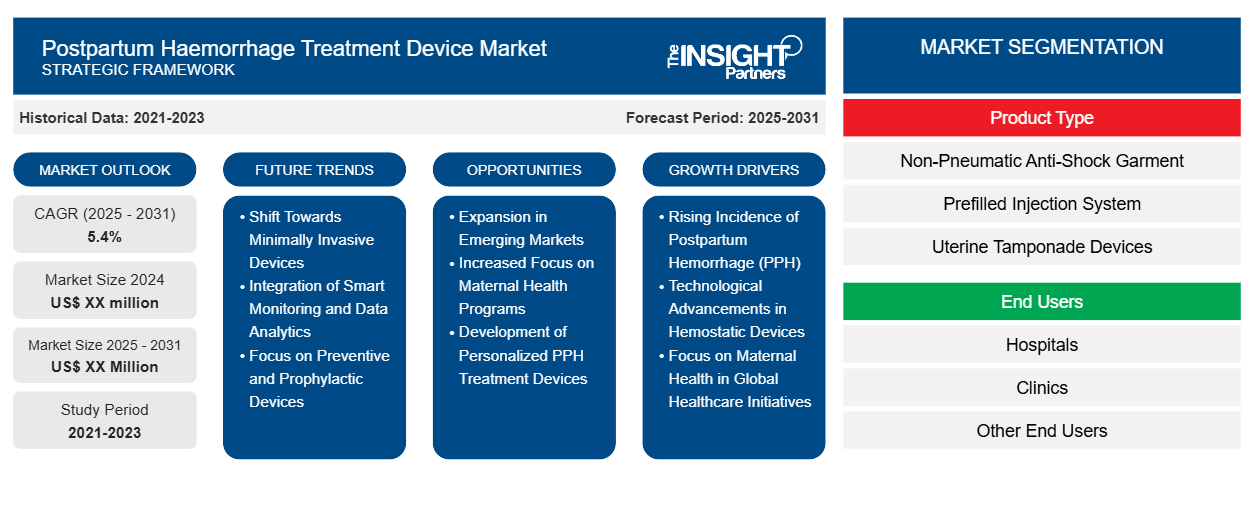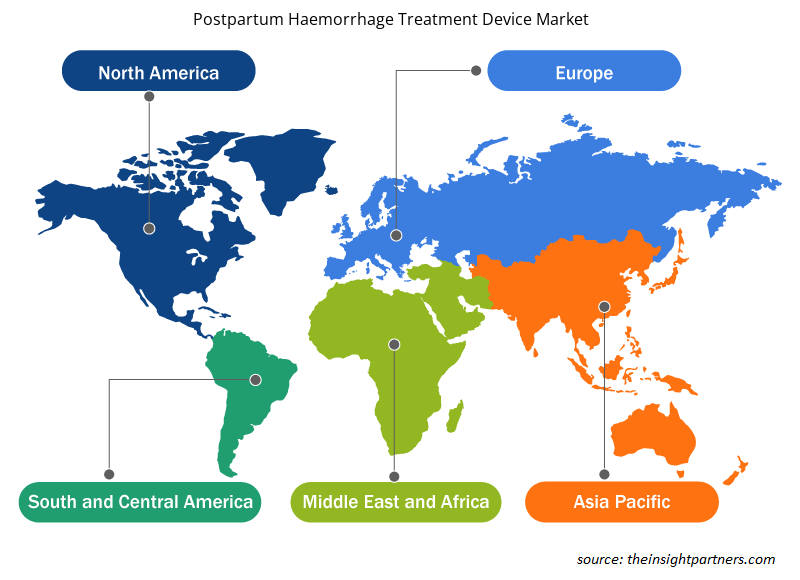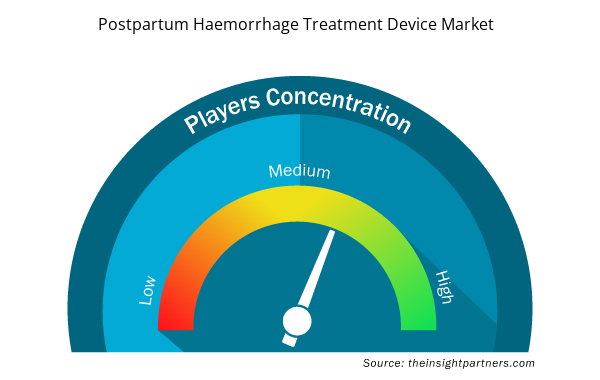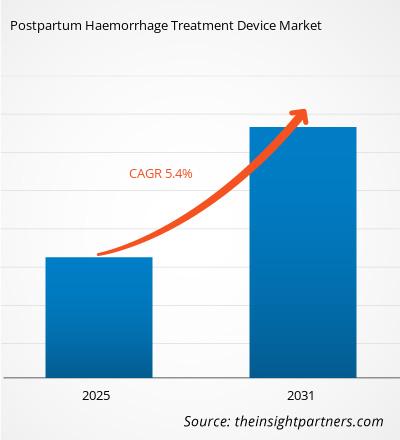The Postpartum Haemorrhage Treatment Device Market is expected to register a CAGR of 5.4% from 2025 to 2031, with a market size expanding from US$ XX million in 2024 to US$ XX Million by 2031.
The report is segmented by Product Type (Non-Pneumatic Anti-Shock Garment, Prefilled Injection System, and Uterine Tamponade Devices), End Users (Hospitals, Clinics, and Other End Users)
Purpose of the Report
The report Postpartum Haemorrhage Treatment Device Market by The Insight Partners aims to describe the present landscape and future growth, top driving factors, challenges, and opportunities. This will provide insights to various business stakeholders, such as:
- Technology Providers/Manufacturers: To understand the evolving market dynamics and know the potential growth opportunities, enabling them to make informed strategic decisions.
- Investors: To conduct a comprehensive trend analysis regarding the market growth rate, market financial projections, and opportunities that exist across the value chain.
- Regulatory bodies: To regulate policies and police activities in the market with the aim of minimizing abuse, preserving investor trust and confidence, and upholding the integrity and stability of the market.
Postpartum Haemorrhage Treatment Device Market Segmentation
Product Type
- Non-Pneumatic Anti-Shock Garment
- Prefilled Injection System
- Uterine Tamponade Devices
End Users
- Hospitals
- Clinics
- Other End Users
Customize This Report To Suit Your Requirement
You will get customization on any report - free of charge - including parts of this report, or country-level analysis, Excel Data pack, as well as avail great offers and discounts for start-ups & universities
Postpartum Haemorrhage Treatment Device Market: Strategic Insights

- Get Top Key Market Trends of this report.This FREE sample will include data analysis, ranging from market trends to estimates and forecasts.
Postpartum Haemorrhage Treatment Device Market Growth Drivers
- Rising Incidence of Postpartum Hemorrhage (PPH): One of the foremost reasons why the market is induced is the rise in cases of postpartum hemorrhage (PPH) especially in developing countries where there are poor maternal health care services. Advanced maternal age, more than one pregnancy, and elective C-sections are some of the reasons paving way for increased instances of PPH. This concern in the healthcare issues increases the need for specialized treatment devices including intrauterine ballons and topical hemostatic agents to curb the deaths associated with the condition.
- Technological Advancements in Hemostatic Devices: Improvements in hemostatic devices such as pressure transducing uterine balloons and energy devices for bleeding control have a positive impact on the postpartum hemorrhage treatment device market. These modern apparatuses are quick to use by the clinicians for the management of PPH due to their gentle non-intrusive nature and ease of use hence reducing the complications and improving patient care. There is thus a growing scope of the market.
- Focus on Maternal Health in Global Healthcare Initiatives: Another key factor propelling the postpartum hemorrhage treatment device market is the shifting trends towards enhancing maternal health outcomes especially in the health systems of the developing countries. There are governmental, non-governmental as well as international agencies which are concerned with prevention of maternal mortality, and postpartum hemorrhage in particular. This has resulted in increased use of treatment systems and procedures in the hospitals and clinics, which has resulted in increase in the market.
Postpartum Haemorrhage Treatment Device Market Future Trends
- Shift Towards Minimally Invasive Devices: One of the most growing trends in the postpartum hemorrhage (PPH) treatment device market is the trend towards less invasive options. Uterine balloon tamponades and other similar devices have been developed that help control the hemorrhage with less surgery. These systems lower risks, fasten the process of healing, and provide alternative methods of constraining PPH which are safer, hence are preferred more in both advanced and low resource areas clinically.
- Integration of Smart Monitoring and Data Analytics: In postpartum hemorrhage treatment devices, yet another trend that is emerging is the use of smart technology and data. More advanced, sensor-monitored devices provide instant results on the levels of uterine contraction, bleeding estimations, and other vitals of the patient. Such technologies not only assists in better medication management, evaluation of the intervention’s efficiency but also helps in better maternal care advancing these devices.
- Focus on Preventive and Prophylactic Devices: It has been noted that there is an increasing concern in the development and manufacture of such devices to prevent postpartum hemorrhage. Such devices that assist in controlling bleeding, especially up to child birth or right after delivery, are being sought to become part of normal birthing processes. Other developments are proactive measures such as those that aim at correcting the situation before it arises, these include the early warning device and also the uterine compression device in high risk pregnancies or for women that have primary postpartum hemorrhage (PPH).
Postpartum Haemorrhage Treatment Device Market Opportunities
- Expansion in Emerging Markets: The market for devices used to treat postpartum hemorrhage (PPH) has high prospects for development in developing countries, which have high maternal mortality rates owing to little access to modern medical devices. Since there has been an improvement in the health care system in the Asia-Pacific, African and Latin American regions, there will be increased demand for affordable and available device for the treatment of PPH, which creates an avenue for the growth of the market and a reach to unserviced countries.
- Increased Focus on Maternal Health Programs: The PPH treatment device market has ample scope due to worldwide efforts aimed at improving the health of women. Due to bodies like WHO informing that there is need to curb maternal morbidity and mortality, the wanting of advanced and dynamic PPH devices will be on the rise. This could be further enhanced by the low-cost Dunbar devices for low fruition centers.
- Development of Personalized PPH Treatment Devices: With the widespread acceptance of the concept of personalized medicine, the opportunity to design a retrospective PPH treatment device is also coming in the way. For instance, such a device may also consider the uterine tone, degree of bleeding, and patient’s co morbid conditions. Therefore, innovations and treatment strategies that focus on precision medicine seem to be promising in preventing and managing PPH and would improve maternal health, open avenues for development and market.
Postpartum Haemorrhage Treatment Device Market Regional Insights
The regional trends and factors influencing the Postpartum Haemorrhage Treatment Device Market throughout the forecast period have been thoroughly explained by the analysts at Insight Partners. This section also discusses Postpartum Haemorrhage Treatment Device Market segments and geography across North America, Europe, Asia Pacific, Middle East and Africa, and South and Central America.

- Get the Regional Specific Data for Postpartum Haemorrhage Treatment Device Market
Postpartum Haemorrhage Treatment Device Market Report Scope
| Report Attribute | Details |
|---|---|
| Market size in 2024 | US$ XX million |
| Market Size by 2031 | US$ XX Million |
| Global CAGR (2025 - 2031) | 5.4% |
| Historical Data | 2021-2023 |
| Forecast period | 2025-2031 |
| Segments Covered |
By Product Type
|
| Regions and Countries Covered | North America
|
| Market leaders and key company profiles |
Postpartum Haemorrhage Treatment Device Market Players Density: Understanding Its Impact on Business Dynamics
The Postpartum Haemorrhage Treatment Device Market market is growing rapidly, driven by increasing end-user demand due to factors such as evolving consumer preferences, technological advancements, and greater awareness of the product's benefits. As demand rises, businesses are expanding their offerings, innovating to meet consumer needs, and capitalizing on emerging trends, which further fuels market growth.
Market players density refers to the distribution of firms or companies operating within a particular market or industry. It indicates how many competitors (market players) are present in a given market space relative to its size or total market value.
Major Companies operating in the Postpartum Haemorrhage Treatment Device Market are:
- Cook Medical
- BD
- Utah Medical Products, Inc.
- BACTIGUARD
- Alydia Health
Disclaimer: The companies listed above are not ranked in any particular order.

- Get the Postpartum Haemorrhage Treatment Device Market top key players overview
Key Selling Points
- Comprehensive Coverage: The report comprehensively covers the analysis of products, services, types, and end users of the Postpartum Haemorrhage Treatment Device Market, providing a holistic landscape.
- Expert Analysis: The report is compiled based on the in-depth understanding of industry experts and analysts.
- Up-to-date Information: The report assures business relevance due to its coverage of recent information and data trends.
- Customization Options: This report can be customized to cater to specific client requirements and suit the business strategies aptly.
The research report on the Postpartum Haemorrhage Treatment Device Market can, therefore, help spearhead the trail of decoding and understanding the industry scenario and growth prospects. Although there can be a few valid concerns, the overall benefits of this report tend to outweigh the disadvantages.
- Historical Analysis (2 Years), Base Year, Forecast (7 Years) with CAGR
- PEST and SWOT Analysis
- Market Size Value / Volume - Global, Regional, Country
- Industry and Competitive Landscape
- Excel Dataset


- Clinical Trial Supplies Market
- Single Pair Ethernet Market
- Resistance Bands Market
- Pressure Vessel Composite Materials Market
- Nuclear Decommissioning Services Market
- Artwork Management Software Market
- Automotive Fabric Market
- Compounding Pharmacies Market
- Workwear Market
- Adaptive Traffic Control System Market

Report Coverage
Revenue forecast, Company Analysis, Industry landscape, Growth factors, and Trends

Segment Covered
This text is related
to segments covered.

Regional Scope
North America, Europe, Asia Pacific, Middle East & Africa, South & Central America

Country Scope
This text is related
to country scope.
Frequently Asked Questions
The postpartum haemorrhage treatment device market is estimated to grow with a CAGR of 5.4% from 2023 to 2031.
Asia Pacific region is likely to witness fastest growth rate during the forecast period.
The postpartum haemorrhage treatment device market majorly consists of the players such as Cook Medical, BD, Utah Medical Products, Inc among others.
The market drivers include rising incidence of postpartum hemorrhage (PPH) and technological advancements in hemostatic devices are driving the postpartum haemorrhage treatment device market
Shift towards minimally invasive devices are likely to remain the key trend during the forecast period
North America dominated the postpartum haemorrhage treatment device market in 2023
Trends and growth analysis reports related to Life Sciences : READ MORE..
1. Cook Medical
2. BD
3. Utah Medical Products, Inc.
4. BACTIGUARD
5. Alydia Health
6. Sterimed Group
7. Angiplast
8. Sara Health Care
9. Boen Healthcare Co., Ltd
10. McKesson Medical-Surgical Inc.

 Get Free Sample For
Get Free Sample For